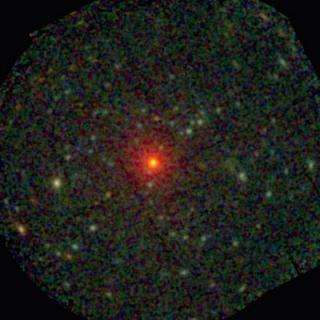Dizzy Little Green Man - XMM-Newton Reveals a Tumbling Pulsar

When the first pulsar was discovered, it was nicknamed LGM-1 or 'Little Green Man 1' because it was beaming such a regular signal into space. Now an international team of astronomers have discovered a pulsar that is tumbling through space in a fashion that would surely dizzy any Little Green Men unfortunate enough to be in the vicinity. Reporting their results in Astronomy & Astrophysics, the scientists explain how this unique object, called RX J0720.4-3125 can shed light on the mysteries of pulsars.
pinning neutron stars, also known as pulsars, are generally known to be highly stable as they rotate. Their periodic signals, either in the radio or X-ray bands, can serve as very accurate clocks. So astronomers using the European Space Agency's (ESA) XMM-Newton X-ray observatory were very surprised when they discovered that RX J0720.4-3125 is not as stable as expected.
"We had initially been using RX J0720.4-3125 to calibrate the instruments on XMM-Newton", says Dr Silvia Zane of University College London (UCL), Mullard Space Science Laboratory (MSSL), "But we noticed that the readings were not as consistent as we expected and took a closer look."
They found that over the past 4.5 years the temperature of this enigmatic object kept rising. Very recent observations have, however, shown that this trend has now reversed and the temperature is now decreasing. According to their recent publication, this effect is not due to a real variation in temperature, but instead is most likely due to a change in the angle from which they are viewing the object. RX J0720.4-3125 is most probably precessing, i.e. there is a slow tumbling of the star, which exposes different areas of the surface over time, as well as spinning on its axis.
The X-ray observations promise to give new insights into the workings of neutron stars, as the fact that it is precessing means RX J0720.4-3125 is not spherically symmetrical but is distorted probably by the extreme magnetic fields.
Neutron stars are one of the endpoints of stellar evolution. With a mass comparable to that of our Sun confined into a sphere of 20-40 km diameter, they are extremely dense and hot. Soon after their birth in a supernova explosion their temperature is of the order of a million degrees. They lose this heat by shining in the x-ray region of the electromagnetic spectrum. Young isolated neutron stars are slowly cooling down and it takes a million years before they become too cold to be observable in X-rays.
"Given the long cooling timescale it was therefore highly unexpected to see its X-ray spectrum changing over a couple of years," said Frank Haberl from the Max-Planck-Institut for Extraterrestrial Physics in Garching, Germany, who led the research group.
It is very unlikely that the global temperature of the neutron star changes that quickly, so the team believe that they are seeing different areas of the stellar surface at different times. This is also observed during the rotation period of the neutron star when the hot spots are moving in and out of our line of sight, i.e. their contribution to the total emission changes. Free precession can be caused by a slight deformation of the star from a perfect sphere which may have its origin in the very strong magnetic field.
Dr Zane adds "Having discovered that the changes observed during the recent years in RX J0720.4-3125 are due to the star undergoing precession, bringing different parts of its surface with different thermal/magnetic properties into view, paves the way to study the surface properties, bringing unique information on neutron star physics. Observations spread over a precession cycle can complement those spread over a spin cycle to provide such unique information about neutron stars."
During the first XMM-Newton observation of RX J0720.4-3125 in May 2000, the observed temperature was at minimum and the cooler, larger spot was predominantly visible, while four years later (May 2004), precession brought into view mostly the second, hotter and smaller spot, increasing the observed temperature.
In their work Haberl et al developed a model for RX J0720.4-3125 which can explain many of the peculiar characteristics which have been a challenge so far. In their scenario the long-term change in temperature is produced by the two hot polar caps which enter into view as the star precesses with a period of about 7-8 years. In order for such a model to work, the two emitting regions need to have different temperatures and sizes. Learning more about the temperature distribution on the surface of a highly magnetized cooling neutron star will provide insights into the magnetic field geometry and its influence on the heat transport through the neutron star crust.
According to the team, "RX J0720.4-3125 is probably the best case to study precession of a neutron star via its X-ray emission which we see directly from the stellar surface. Precession may be a powerful tool to probe the neutron star interior and learn about the state of matter under conditions which we can not produce in the laboratory. Additional XMM-Newton observations are planned to further monitor this intriguing object. We are continuing the theoretical modelling from which we hope to learn more about the thermal evolution, the magnetic field geometry of this particular star and the interior structure of neutron stars in general."
Source: PPARC
















